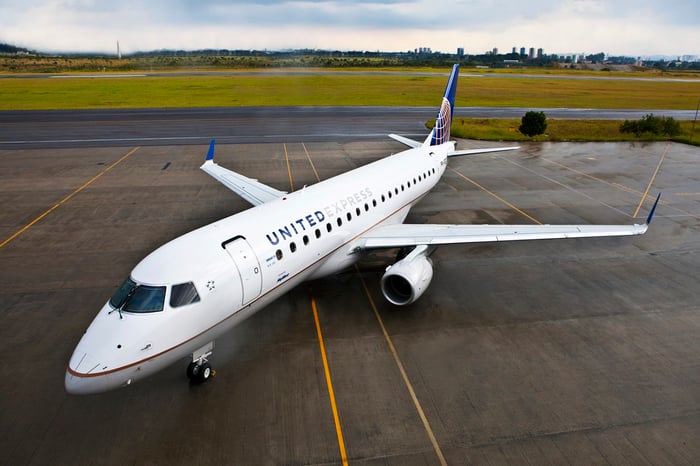In late 2018, United Airlines (UAL 3.27%) announced that it would buy 49.9% of regional airline ExpressJet from SkyWest, through a new joint venture called ManaAir. The $70 million deal closed in early 2019.
At the time, buying a major stake in ExpressJet seemed like a reasonable strategic move to give United more negotiating power vis-a-vis the third-party regional airlines that operate most of the United Express fleet. However, the COVID-19 pandemic changed that in an instant. As a result, United Airlines recently confirmed that it will wind down its contract with ExpressJet by the end of this year, which will almost certainly lead to the latter's demise.
Changing course on ExpressJet
At the beginning of 2020, United Airlines had contracts with eight separate regional airlines to operate parts of its United Express regional network. Several of those airlines also operated multiple different aircraft types for United.
There's some benefit to fostering competition between regional airlines in order to get favorable pricing, but there was clearly too much complexity in these regional flying arrangements. United Airlines began to address that complexity earlier this year. It announced the end of its partnership with Trans States Airlines, which has since shut down. Trans States would transfer 36 50-seat Embraer E145 aircraft to ExpressJet, which would in turn send all of its larger E175 jets to SkyWest, becoming an E145-only carrier.

ExpressJet phased out all of its E175s earlier this year. Image source: United Airlines.
ExpressJet's E175s are gone now. Unfortunately, the E145s are going away, too. Last week, United notified its two remaining E145 operators -- ExpressJet and CommutAir -- that it would only need one E145 partner going forward. CommutAir had the advantage, mainly because it has a lower cost structure than ExpressJet.
Despite last-minute attempts by ExpressJet to renegotiate labor costs, United Airlines confirmed late last week that it had chosen CommutAir. Given that ExpressJet doesn't have flying contracts with any other airlines, it is likely to shut down by the end of 2020.
Behind the times
The COVID-19 pandemic -- which has dramatically impacted air travel demand, especially for United -- was the immediate cause of ExpressJet's demise. However, the regional carrier's long-term outlook was bleak regardless.
Under the previous plan for ExpressJet to grow its E145 fleet, United Airlines had said that the planes would be upgraded with new seats, streaming inflight entertainment, and other interior improvements. This would have helped make the jets more appealing to customers. However, they still would have been far less comfortable than the 65- to 76-seat regional jets that are far more common in U.S. full-service airlines' regional fleets today.
Whereas larger regional jets have full-height cabins, adequate room for carry-on bags, and first-class sections, E145s have low ceilings, tiny overhead bins, and (typically) single-class seating. This makes United Airlines' reliance on 50-seat jets a major competitive disadvantage. Entering 2020, United's regional fleet had over 300 E145 and CRJ200 50-seat jets: more than American Airlines and Delta Air Lines combined.
Moreover, nearly all of ExpressJet's E145s were built in the early 2000s, with a handful built as recently as 2006. Rising maintenance costs would have made it increasingly uneconomical to keep this fleet in service over the next decade. Thus, most of ExpressJet's planes are likely to remain parked for good.
A Pyrrhic victory for CommutAir
In the short term, CommutAir has a new lease on life, as it will become United's only regional partner operating E145s. However, without any larger regional jets in its fleet, CommutAir is at risk of going bust when United eventually phases out its 50-seat jet fleet for good.
United Airlines needs to either renegotiate its pilot contract or add a fleet of small mainline jets to gain the right to replace aging 50-seat jets with an expanded fleet of large regional aircraft. Either option would be preferable to falling further behind its rivals in terms of passenger experience. That represents an existential threat to any regional airline that is wholly reliant on 50-seat jets.





